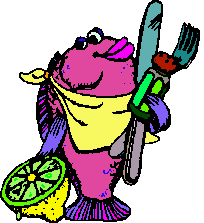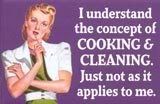Thursday, January 31, 2008
Wednesday, January 30, 2008
Monday, January 28, 2008
Cooking Salmon in a Dishwasher
Cooking Salmon in a Dishwasher

Needs:
- salmon fillets
- aluminum foil
- a lemon
- a few butter pats
- electric dishwasher
Place the fish on two large sheets of aluminum foil. Squeeze on some lemon juice and place the pats of butter on the salmon fillets. Seal the fillets well in the foil, and place the foil packet in the top wire basket of your electric dishwasher. DO NOT ADD SOAP OR DETERGENT. Close the dishwasher door, set the dishwasher on the hottest wash cycle, complete with drying cycle, and let it run through a full cycle. When the cycle is complete the fish will be cooked just right.
Tips for Healthy Cooking
Tips for Healthy Cooking
When cutting back on sodium, fat (particularly saturated and trans fats) and cholesterol, how you cook is just as important as what you cook. People with heart failure and their families don't have to give up taste or the foods they love. Often minor changes in how favorite foods and recipes are prepared can make a big difference.The first goal for many people with heart disease is to reduce the amount of salt they eat. This is usually more important than controlling saturated fat and cholesterol consumption. If you usually add salt while cooking, simply put the salt shaker out of reach. Don't season meats and vegetables with prepackaged mixes, which often contain a lot of salt. Don't fry foods in oil, which adds unwanted fat and calories. Instead, try some of these healthier techniques:
- Stir-fry. Use a wok to cook vegetables, poultry and seafood in vegetable stock, wine or a small amount of oil. Avoid high-sodium seasonings like teriyaki and soy sauce.
- Microwave. This is a good alternative because it's fast and doesn't add fat or calories.
- Roast. Put a rack in the pan so the meat or poultry doesn't sit in its own fat drippings. Instead of basting the meat with pan drippings, use fat-free liquids like wine, tomato juice or lemon juice. When making gravy from the drippings, use a gravy strainer or skim ladle to remove the fat.
- Grill or broil. Always use a rack so fat drips away from the food.
- Bake. Bake foods in covered cookware with a little extra liquid.
- Poach. Cook chicken or fish by immersing it in simmering liquid.
- Sauté. A pan made with nonstick metal or coated with a nonstick surface is a terrific investment, because it lets you use little or no oil without having food stick. You also can use a nonstick vegetable spray, a small amount of broth or wine, or a tiny bit of oil rubbed onto the pan with a paper towel. When necessary, use liquid vegetable oils that have no more than 2 g of saturated fat per tablespoon.
- Steam. Steam vegetables in a basket over simmering water. They'll retain more flavor and won't need any salt.
Make favorite recipes healthier by substituting ingredients to cut down on the content of fat (particularly saturated fat). You and your family probably won't even notice a difference in taste. This table can help you get started.
| When your recipe says . . . | . . . Try this instead |
| Whole milk (1 cup) | 1 cup fat-free or nonfat milk plus one tablespoon of unsaturated oil |
| Heavy cream (1 cup) | 1 cup evaporated skim milk or 1/2 cup low-fat yogurt and 1/2 cup plain low-fat cottage cheese |
| Sour cream | Low-fat cottage cheese plus low-fat or nonfat yogurt (fat-free sour cream is also available) |
| Cream cheese | 4 tablespoons margarine blended with 1 cup dry low-fat cottage cheese; add a small amount of fat-free milk if needed |
| Butter (1 tablespoon) | 1 tablespoon polyunsaturated margarine or 3/4 tablespoon polyunsaturated oil |
| Shortening (1 cup) | 2 sticks trans-free polyunsaturated margarine |
| Egg (1) | 1 egg white plus 2 teaspoons of unsaturated oil or commercially made, cholesterol-free egg substitute |
| Unsweetened baking chocolate (1 ounce) | 3 tablespoons unsweetened cocoa powder or carob powder plus 1 tablespoon polyunsaturated oil or margarine. Carob is sweeter than cocoa, so reduce sugar in recipe by 1/4 |
Friday, January 25, 2008
Thursday, January 24, 2008
Total Body Toning Cardio Workout Video
This is great and it's free. I can't wait for warmer weather to do this!!!
Six Ways Stores Trick You Into Spending More
Six Ways Stores Trick You Into Spending More
It's one of life's ironies that retailers try to lure you into their stores with low prices, only to do everything in their power to make sure you spend more than you intended once you're inside.
It's important to understand these methods so you don't fall for them.
Double Discounts: Retailers know that most people aren't good at math, and they take advantage of this. More and more are using double discounts to earn more money while making customers think they are getting a better deal than they actually are.
| More From TheStreet.com: • It May Be Time to Refi, if You Play it Smart • When to Refinance, When to Sit Tight • How to Keep Heating Oil From Torching Your Budget |
For example, if you are given a choice of buying a $100 item at 45% off, or buying the same item at 20% off with 30% additional taken off at the register, which would you choose? Most people simply add the 20% and 30% and assume that they are getting 50% off the item.
When you do the math, however, it doesn't work out that way. Taking 45% off of $100 means the item sells for $55. But if 20% off $100 is $80; taking 30% off that $80 leaves you with an additional $24 discount, for a price of $56, or a dollar more.
A 2007 study published in the Journal of Consumer Research indicates that shoppers are likely to feel the double discount is a better value.
Fight Back: Do the math before buying. If you can't do the calculations in your head, purchase an inexpensive calculator and carry it around when you go shopping. If you see an item that comes with a double discount, the store may be attempting to make you believe you are getting a better price than you are.
Pricing items at $9.99 vs. $10: Studies have found that when prices end in 9, consumers end up spending more money. While this might seem strange, there are various theories as to why this happens. Most note that when people process information, the first number they read has a stronger impression than the following numbers. So $9.99 seems much lower than $10.
Another theory is that pricing items this way makes it more difficult to calculate and compare unit prices. For example, if a 200-ounce package of an item is $3 and a 400-ounce package of the same item is $5, it's fairly easy to calculate that the 400-ounce package is a better value.
But when the same items are priced $2.99 and $4.99, respectively, they may appear to be the approximately same price, since the first numbers are what register and two is half of four.
Fight Back: Instead of looking at the first number, make a conscious effort to round everything up when doing your calculations. This is another reason to take a calculator when you shop: it can help you work out the true price if you have trouble doing calculations in your head.
Three for $9.99: Stores will often offer multiple items for a single price, such as three for $9.99. Most people assume that they need to purchase three of the items to get this "special" price so they buy more than they really need.
The truth is that unless the items are marked at higher individual prices or the label says something like "must purchase quantity stated to get discount," you can buy a single item for $3.33.
Fight Back: Get in the habit of purchasing only the amount you really need.
Buy One, Get One Free: This is another promotion that can mislead you into thinking you're getting a good deal. It's often difficult to tell whether you would pay half as much for purchasing a single unit or, for that matter, whether the price of a single unit has been inflated to take into account the extra item being "given away."
Many times the "buy one, get one free" offers are not better than the regular price of purchasing two items.
Fight Back: Before purchasing a buy-one-get-one-free item, find out what the regular price of that item is. Then do the math to see if you're really getting a bargain.
"Sale" doesn't mean a discount price: Retailers play on the assumptions you make. Consumers are trained that "sale" means a good price and these items are usually advertised in big, bright lettering at the end of store aisles. The problem is that what the stores call a "sale" may not give you a very good price. (Check out The Grocery Store Game (Janine Bolan), page 28, for other tips of this ilk.) So the casual passerby will see the item is "on sale" and buy the product assuming it's a good price, when it isn't necessarily so.
Fight Back: Don't assume things on the end of an aisle or that are marked as "on sale" are actually a good price. Make a grocery price book so you know a good price and always compare the prices with other similar items.
Putting things at eye level: When you walk down the aisles of the store, notice what items are at eye level. They will be the ones that are the most profitable for the store, which usually means the most expensive ones. This is because stores know you are much more likely to see and choose something at eye level than something on the top or bottom shelf.
Fight Back: When shopping, be sure to look high and low before deciding which product to purchase. You'll often find what you're looking for at a lower price on another shelf.
Stores are quite sophisticated when it comes to getting you to part with your money. If you understand how they are trying to manipulate you, you are less likely to fall into these traps and hold onto more of your hard-earned money.







